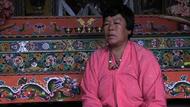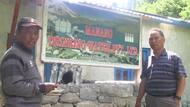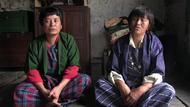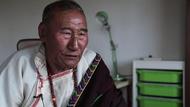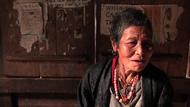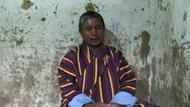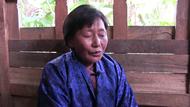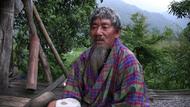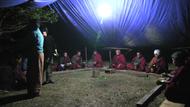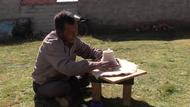Video Overview
This account is about the origin of the Thromang temple. It was believed that Jomo was in search of her own residence after the completion of her dharma training. She tried to find a proper location at several places but in the end, after her arrival at a place called Choetorsa, she threw every page of her dharma text in the air and landed at a place called Thromang. Here the present temple is located in which every page is compiled together and forms one volume of the book. Jomo constructed her residence at this place.
- Chaling
- ནོར་བུ Norbuད་ ཁྲོ་མང་ཆགས་པའི་ ཆགས་བརྒྱུད་འདི་ལུ་ དང་པོ་ཨ་མ་ཇོ་མོ་གིས་ ཏེ་ ཆོས་འདི་ཞུ་སྟེ་ ཨ་མ་ཇོ་མོ་ གདན་ས་འཚོལ་མ་ཐོབ་པར་ ཤིང་མཁར་ལའུ་རི་ལས་མར་བྱོན་ཏེ་ མར་ཇོམ་པ་ནི་ཟེར་ས་ ལྷོདཔ་ད་ལུ་ ཇོ་མོ་ཨ་ནི་ཨེ་ནི་ཟེར་ ཏེ་ མོ་གི་སྲས་མོ་གཉིས་ ཨ་ནཱ་ལུ་གནསམོ་སྦེ་ བྱིན་ཡི་ཟེར་ཨིན་ལགས།The origin of thromang traces back to aum jomo where after receiving the dharma teachings and unable to find a proper place to reside, she reached jompani via shingkhar lowri and there jomo ani auni gave her two daughters hand for marriage.
- ནོར་བུ Norbuཏེ་ དེ་ལས་ ཨ་ནཱ་ལས་ ཏེ་ མོ་གདན་ས་འཚོལ་མ་ཐོབ་ཞིནམ་ལས་ ད་ རྐང་པར་ཟོར་གདུང་ལུ་བྱོན་ཏེ་ ད་ལྟོ་གི་ ཇོ་མོ་གིས་ ཆགས་ཚུལ་ ཟླ་བ་ ༧ པ་ནང་ལུ་ ཁོང་གིས་ཇོ་མོ་གསོལ་ནིའི་ལུགས་སྲོལ་ཅིག་ཡོད། ཨ་ནཱ་གིས་ ནཱ་ལུ་བྱོན་ཡོདཔ་ཨིན། ཨ་ནཱ་ལས་ ཏེ་ ཨ་མ་ཇོ་མོ་གིས་ བྱོན་ལ་ཟེར་ས་ལུ་ བྱོན་པའི་སྐབས་ བྱོན་ལ་ལུ་ལྷོདཔ་ད་ལུ་ ཨམ་ཇོ་མོ་གིས་ ཏེ་ རྨགཔ་འདི་ ཨ་ནཱ་ལུ་ སྐུ་སྙུངས་ཏེ་གཤགས་ཡི་ ཟེར་ཞིནམ་ལས་ ཇོ་མོ་གིས་ ཟླ་བ ༧ པའི་ཚེས་ ༢༠ གི་ཚེ་ ཇོ་མོ་ཟེར་ ཕབ་ནི་ཅིག་ཡོད།Unable to find her proper place to reside, she went to kangpar zordung and settled there and people of zordung celebrate her life in the seventh month of Bhutanese calendar. After that, she went to place called jonla where her husband died of illiness and people remember her on 2oth day of seventh month in Bhutanese calendar.
- ནོར་བུ Norbuཇོ་མོ་ཕབ་སྟེ་ ང་བཅས་ ཉིནམ་བཞི་བཞི་ལྔ་ལྔ་ཅིག་གིས་ཧེ་མ་ལུ་ ང་བཅས་ཆུང་ཀུ་བསྒང་ལུ་འབད་བ་ཅིན་ ཨའུ་ལ་ཟེར་ ཕབ་ནི་སྡོད་ཅི། ཨའུ་ལ་ཟེར་ འབད་བའི་སྐབས་ལུ་ ཉིནམ་བཞི་བཞི་ལྔ་ལྔ་[ས་གཉན?] འབད་དེ་ དེ་ལས་ ཨ་ནཱ་ཆོས་བསྐོར་ཅིག་འབད་དེ་ ཁོང་ཨའུ་ལ་ ལྷ་ཅིག་གསོལ་ནི་འདུག ལྷ་གསོལ་སྟེ་ ཉིནམ་བཞི་བཞི་ལྔ་ལྔ་འབད་དེ་ ཨའུ་ལ་གསོལ་ནི་ཟེརཝ་ད་ལུ་ གནམ་མེད་ས་མེད་ཀྱི་ ང་བཅས་ལུམ་པ་གིས་མི་དང་ ནཱ་ལུ་ཡང་འདྲོགས་ཏེ་སྡོད་ནི་འདུག་ཟེར་ཨིན།As we were little child, we used to celebrate the day called aaula for four to five days in which people turn the wheel of the dharma and appeases the gods which is quite frightening.
- ནོར་བུ Norbuདེ་ལས་ ཨ་ནཱ་ལས་ ཨམ་ཇོ་མོ་ ནཱ་ལས་ཡར་ བྱོན་ཞིནམ་ལས་ ཡར་ཆོས་གཏོར་ས་ཟེར་ས་ལྷོདཔ་ད་ལུ་ ད་ གསེར་གྱི་གླེགས་བམ་ ཏེ་ ད་ འ་ ཏེ་ ད་ ཉི་ཁྲི་ བུམ་ག་ར་ཞུ་སྟེ་འབགཔ་ད་ལུ་ ཏེ་ ད་ ཁྱོད་ར་གདན་ས་ར་འཚོལ་ཏེ་སོང་ད་ ཏེ་ ད་ ནཱ་ལུ་ཞུ་མི་ཚུགས་པས་ཟེར་ ཏེ་ ཁོ་ གདན་ས་འཚོལ་ཏེ་སོང་ཟེརཝ་ད། ཆོས་གཏོར་ས་ཟེརཝ་ད་ལུ་ ཆོས་འདི་གཏོར་བཏང་ཡི་ཟེར་ཨིན། ཆོས་གཏོར་བཏངམ་ད་ལུ་ ཆོས་ཐམས་ཅད་ར་ རླུང་མ་གིས་འབག་སྟེ་ ཁྲོ་མང་ཟེར་ས་ལྷོདཔ་ད་ལུ་ ཤིབ་སྟེ་སྡོདཔ་ད་ལུ་ ཁོ་ གདན་ས་འཚོལ་ཏེ་སོང་ཟེར། ཨ་ནཱ་ལུ་ ཏེ་ མི་ཚུ་གིས་མཐོང་སྟེ་ ཁྲོ་མང་གི་ལྷ་ཁང་ཟེར་ཆགས་དགོ་པའི་ གནད་དོན་ཨ་ནཱི་སྦེ་ཨིན་ཟེར།Aum jomo carried many volumes of Buddhist scripture and after reaching to the place called choetorsa, she scattered the pages in the air and that is how the places name is derived. As she scatters the pages in the air, the wind blew the pages and compiled iself at the place called thromang. The people found the volume of scripture and cinstructed a monastery there on the spot.
- ནོར་བུ Norbuཏེ་ ཨ་ནཱ་ལས་ ཆོས་ཤོ་ལེབ་གསུམ་འདི་རླུང་མ་གིས་འབག་ཡི་ཨིན་ལགས། རླུང་མ་གིས་འབག་སྟེ་ ཡར་ཆོམ་བྲུག་ས་ཟེར་ཅིག་ཡོད། ཨ་ནཱ་ རྡོ་གུ་སྦྱར་ཏེ་སྡོད་སྡོདཔ་བཟུམ་ཅིག་ཡོད། རྡོ་གུ་སྦྱར་སྡོད་ཞིནམ་ལས་ ད་ལྟོ་ཡང་ ཆོས་ ཆོས་མཇལ་ཚུགས་ནི་བཟུམ་སྦེ་ སྦོ་ལོག་ཁར་ སྦྱར་བ་ཅིན་ རྡོ་རང་ཨིན། ས་ཐག་རིང་ས་ལས་བལྟ་བ་ཅིན་ ཡི་གུ་རང་ཨིན། ཨ་ནཱི་བཟུམ་སྦེ་ ཞལ་མཇལ་ནི་ཡོད་ཟེར་ཨིན་ལགས་ ཨ་ནཱ།But the wind blew the three pages of the scripture and it attached to the rock at the place called choebum. Still today we could see the imprints. We could see rock if we go near to it but looks like scripture if we looks from afar.
- ནོར་བུ Norbuཏེ་ ད་ རྒྱལ་སྲས་ག་ན་པ་ཏི་གིས་ལོ་རྒྱུས་འདི་ཞུ་བ་ཅིན་ ལོ་འབད་བ་ཅིན་ ད་ལྟོའི་དུས་ཚོད་ལུ་འབད་བ་ཅིན་ ལོ་གསུམ་བརྒྱ་བཞི་བརྒྱ་ནང་ན་སོང་ནུག ཨ་ནཱི་སྐབས་ལུ་ རྒྱལ་སྲས་ག་ན་པ་ཏི་ཟེར་མི་འདི་ཆགས་ཏེ་ ནཱ་སྡོད་མི་འདི་གིས་ དང་པོ་ཚུ་གིས་ ཏེ་ ད་ལྟོ་ འ་ ལྷ་ཁང་གིས་རྙིངམ་དང་ ཧྲམ་མི་ག་ར་ཨ་ནཱི་རྣམ་ཐར་དང་འཁྲིལ་ཏེ་ར་ཡོད་ལགས་ ཨ་ནཱི་འདི། ཏེ་ ད་ ལྷ་ཁང་ཆགས་པའི་ཆགས་ཚུལ་འདི་ཨ་ནཱི་སྦེ་ཨིན་ལགས།300 to 400 years ago, Gyelsey Ganapati lived here and even today the ruins of the monastery can be seen as per the scriptures recorded in commentary.
- ནོར་བུ Norbuདེ་ལས་ བཅའ་གླིང་ཟེར་ འཐོན་མི་འདི་ ད་ མང་ཤོས་ཅིག་གིས་ ང་བཅས་བྲཱ་མི་ཁ་སྐད་ནང་བཅའ་གླིང་ཟེར་ རྩེ་རི་རྫམ་ལས་བརྟེན་ཏེ་ བཅའ་གླིང་ཟེར་སླབ་དོ། ཨ་ནི་ལས་བརྟེན་ བཅའ་གླིང་ཟེར་སླབ་དོ། ཏེ་ ལ་ལུ་གིས་ རྒྱལ་སྲས་ག་ན་པ་ཏི་གི་བླ་མ་འདི་ ནཱ་ལུ་བཞུགས་ཏེ་ ཨ་ནཱ་ལུ་ མ་བཞུགསཔ་ལས་ སྐྱོ་བའི་སྐྱོ་གླིང་ཟེར་སླབ་མས། སྐྱོ་གླིང་འདི་མེན། སྐྱ་གླེང་འདི་ ངེས་བདེན་བདེན་ར་ཨིན།The name of the place Chaling is named after the bridge called cheri. From one account, lama ganapatis lama was received at this place but he did not stay and the place was named with the connotation of sadness. For me its not choling but its chaling.
- ནོར་བུ Norbuང་བཅས་བྲཱ་མི་ཁ་སྐད་ནང་རྩེ་རི། རྩེ་རི་གི་མིང་འདི་ སྐྱ་གླེང་ཟེར་རང་སླབ་འོང་། བཅའ་གླིང་ཆགས་དགོ་པའི་གནད་དོན་ ག་ཅི་ཟེར་བ་ཅིན་ ཨ་རྒས་ཧྲི་དར་ཕུན་ཚོགས་ཟེར་མི་གིས་ རྩེ་རི་རྫམ་སྟེ་ ཏེ་ ད་ ཁོ་དང་པོ་ ཁོ་གིས་ཆགས་ཞིནམ་ལས་ ཨ་ནཱ་ལུ་ ཏེ་ རྩེ་རི་གི་མིང་འདི་ སྐྱ་གླེང་ཟེར་སླབ་འོང་། སྐྱ་གླེང་ སྐྱེ་ཟེར་སྡོད་ཡི་ཧེ་མ་འདི། ཨ་ནཱི་སྦེ་ཨིན་ཟེར་ཞུ་ནི་ལགས། ལ་སོ།In our local dialect, brami, we pronounce as chaling after old man by name rhre and phuntsho founded the cheri bridge. Initially it was called chaling chey. That’s how it is.
 Loading ...
Loading ... 